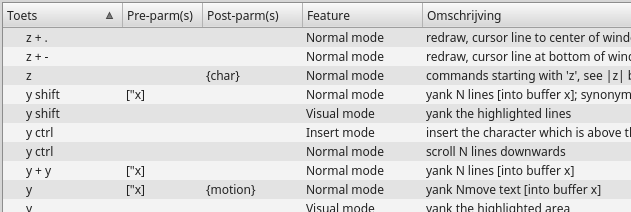Hotkeys: currently supported tools
Each list at least contains the columns key, modifiers and description Some tools work with internal commands or command numbers, so they use columns for those too. When it's possible to redefine keys, a "type" column will show this.
Total Commander, a 2-pane file manager for Windows

type indicates whether the key combo has been (re)defined or not
command is the associated internal or user-defined command
An editor for the keyboard shortcuts is also available - in fact, it's the only one I made yet:

Note that this plugin is included in the examples, but not activated.
VI(M), a versatile text editor for Unix and Windows and other OSes

the key column contains keys as well as modifiers because it also contains double keys sometimes
pre-parm(s) indicates an optional parameter that you can type in preceding the command with (except for the number of repetitions which is implied)
post-parm(s) indicates an optional parameter that you can type in following the command
Opera, a better web browser (up to version 12)

The columns follow the structure of the keyboard definition files
key contains keys as well as modifiers
context refers to the part of the application
platform refers to the OS
feature has to do with specific functionality that can be activated
type indicates whether it's redefined or not
I've also included a plugin for the new Opera but while I'm still using old Opera for mail, I'm not using the new one anymore. They're basically different browsers and they don't look much the same.
SciTE, a cross-platform graphical text editor

context: for all commands it's possible to specify to which file type(s) the apply. File types are commonly defined by extension.
platform: it's also possible to specify which platform(s) a command applies to. Platform actually refers less to the OS as to the compile environment SciTE was built against. For instance, on Windows it could also be CygWin.
type indicates whether it's redefined or not
code and command: SciTE knows two types of commands: some correspond to a number and some don't. Commands can also be executables with parameters like they could be run from the command line.
Double Commander, a two-pane file manager for Linux and Windows

key contains keys as well as modifiers
type indicates whether it's redefined or not
context refers to the part of the application
parameter shows which parameter(s) a command takes
controls: not quite sure what this means. I think it indicates what portion of the UI the shortcut is restricted to.
The above tools I've made plugins for, because I found out where they store their settings. I've included some other tools I work with but for them I only built a csv file because that's what the application minimally needs, the plugin is mainly for reading from and writing to the tool's settings files:
hotkeys to be used in the shell (Bash)
keys that can be used in controlling Linux Mint behaviour
keys for Kdiff3, GIMP, Audacity, FileZilla - some tools I use ocasionally
keys for Vivaldi, the web browser that I replaced Opera with and for Firefox, which I use for things that don't work yet in V as it's not completely finished yet (but already very powerful).